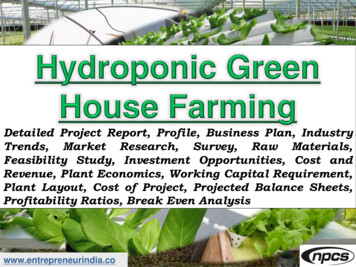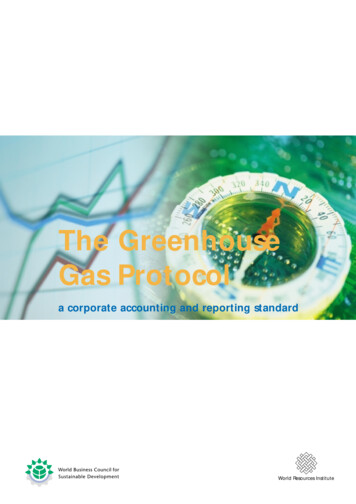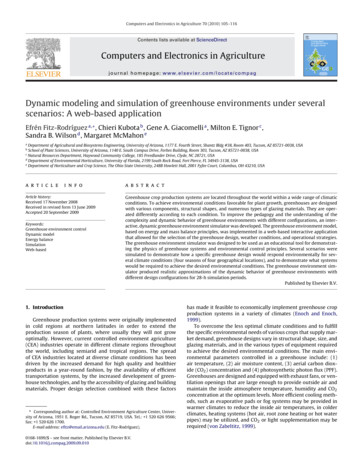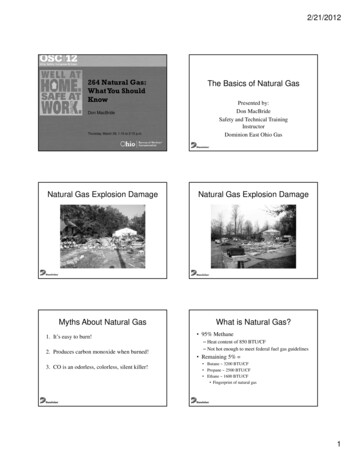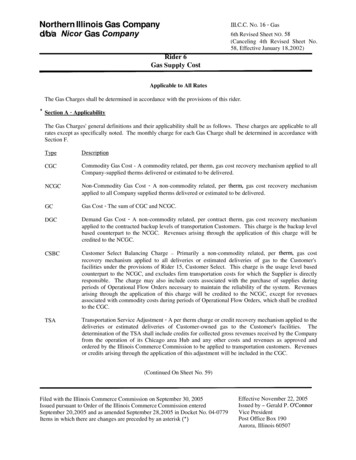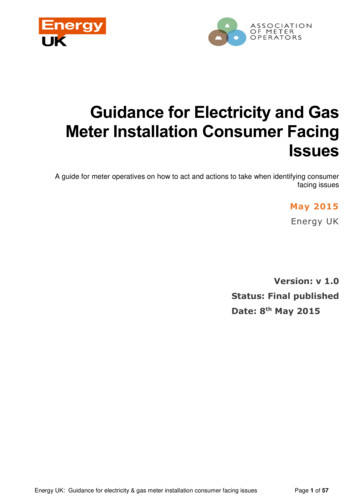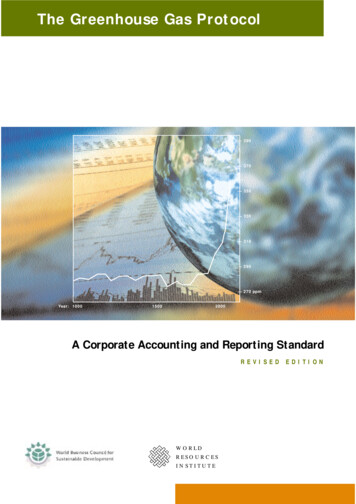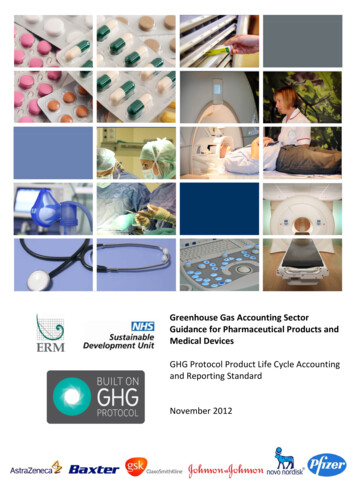
Transcription
Greenhouse Gas Accounting SectorGuidance for Pharmaceutical Products andMedical DevicesGHG Protocol Product Life Cycle Accountingand Reporting StandardNovember 2012
Greenhouse Gas Accounting SectorGuidance for Pharmaceutical Products andMedical DevicesNovember 2012This guidance has been reviewed by WRI for conformancewith the GHG Protocol Product Life Cycle Standardhttp://www.sdu.nhs.uk/pharma-mdPrepared by Tom Penny, Karen Fisher, Michael Collins and CharlesAllisonFor and on behalf ofEnvironmental Resources ManagementApproved by: Charles AllisonSigned:Position: PartnerDate: 30 November 2012This report has been prepared by Environmental ResourcesManagement the trading name of Environmental ResourcesManagement Limited, with all reasonable skill, care anddiligence within the terms of the Contract with the client,incorporating our General Terms and Conditions of Businessand taking account of the resources devoted to it byagreement with the client.We disclaim any responsibility to the client and others inrespect of any matters outside the scope of the above.This report has been prepared for the client and we accept noresponsibility of whatsoever nature to third parties to whomthis report, or any part thereof, is made known. Any suchparty relies on the report at their own risk.Environmental Resources Management LimitedIncorporated in the United Kingdom with registration number 1014622Registered Office: 2nd Floor, Exchequer Court, 33 St Mary Axe, London, EC3A 8AA
CONTENTSFOREWORD1ACKNOWLEDGEMENTS2GLOSSARY OF TERMS3COLOUR BOXES51INTRODUCTION61.11.21.31.41.51.61.7THE PURPOSE OF THIS GUIDANCE DOCUMENTHOW THE DOCUMENT IS STRUCTUREDHOW TO USE THE DOCUMENTWHO SHOULD USE THE GUIDANCE DOCUMENT?HOW WAS IT DEVELOPED?THE SCOPE OF THIS GUIDANCE IN THE CONTEXT OF WIDER GHG ACCOUNTING METHODS ANDSTANDARDSGHG ACCOUNTING IN THE PHARMACEUTICAL AND MEDICAL DEVICES SECTOR2CORE PRINCIPLES, RECOMMENDATIONS AND COMMON ACCOUNTING ASPECTS 182.12.22.32.42.52.6STANDARD TERMINOLOGIESCORE ACCOUNTING PRINCIPLESOVERVIEW OF KEY STEPSCOLLECTING DATA AND ASSESSING DATA QUALITYCONSIDERING UNCERTAINTYCALCULATING PRODUCT GHG INVENTORY RESULTS1818182028283R&D, CLINICAL TRIALS AND MARKETING304PHARMACEUTICAL PRODUCTS314.1TYPES OF PHARMACEUTICAL PRODUCT AND PRODUCTION PROCESSES CONSIDERED IN THISGUIDANCESTRUCTURE OF MODULE GUIDANCECOMMON PHARMACEUTICAL GUIDANCEMODULE GUIDANCE: PRODUCTION OF ACTIVE PHARMACEUTICAL INGREDIENTS (APIS)Synthetic Organic ChemicalsCell CultureEgg-Based CultivationConjugate VaccinesPlant-Based ExtractionAnimal and Human DerivedMODULE GUIDANCE: PROCESSING INTO DELIVERY 24.4.34.4.44.4.54.4.64.5681012131416
4.5.14.5.24.5.34.5.44.5.54.5.64.5.7Solid Dose FormsLiquid Dose FormsCreams and OintmentsPatchesGasesAdministering DevicesPackaging717680838588925MEDICAL DEVICES975.15.25.35.3.15.3.25.3.35.3.45.3.5TYPES OF MEDICAL DEVICE CONSIDERED IN THIS GUIDANCESTRUCTURE OF MEDICAL DEVICES GUIDANCECOMMON MEDICAL DEVICE GUIDANCEDescriptionBoundary SettingUnit of AnalysisPrimary Data and AllocationSecondary Data Sources97981011011011171181226DISTRIBUTION AND DELIVERY1257USE PHASE OF PRODUCT LIFE CYCLE1328END-OF-LIFE1408.18.28.3GENERAL GUIDANCESPECIFIC GUIDANCE: NON-HAZARDOUS WASTESPECIFIC GUIDANCE: HAZARDOUS AND CLINICAL WASTE1401431439COMMUNICATION, REPORTING AND ASSURANCE1469.19.29.3COMMUNICATION SUPPORTEDREPORTING RECOMMENDATIONSASSURANCE AND VERIFICATION14614614910CARE PATHWAYS151ANNEX AGUIDANCE DEVELOPMENT: GOVERNANCE AND CONSULTATION PROCESSESANNEX BRELATED AND OTHER STANDARDSANNEX CEXAMPLE DATA COLLECTION TEMPLATEANNEX DEXAMPLE SAMPLING APPROACHES
FOREWORDThe pharmaceutical and medical device sectors are central to healthcare combatinggreenhouse gas emissions and reducing our impact on the environment. In 2010 anestimated 22% of NHS England’s greenhouse gas emissions were attributable topharmaceuticals and 8% to medical devices.I am therefore delighted to see the NHS, the pharmaceutical and medical deviceindustries, international health experts, and greenhouse gas accounting specialistsworking together to produce these international guidelines. This guidance will formthe cornerstone of our joint action to reduce environmental impact and provide afantastic example to other sectors of how to tackle climate change and developsustainably in partnership. It is the first international greenhouse gas life cycleassessment guidance for the pharmaceutical and medical device sectors, and onlythe second of its kind for any sector.Measuring greenhouse gas emissions in a consistent manner across nationalboundaries will help us all understand where the emission “hot-spots” are, andconsequently where we initially need to focus our attention to achieve the greatestpossible impact.This guidance marks an important first step. It will be a globally relevant, livingdocument that is freely available, and continually revised and updated. It isinternational in its scope, encourages transparent and accurate reporting, and helpsto create a common language and methodology that will form the basis for furtherdevelopment.What is being proposed is in the interest of all of us, to gain a better understandingof what is good for business, good for health, and good for our common future.I would like to thank all those involved from the different countries and differentsectors in breaking new ground.Sir Neil McKay CBNHS CEO of NHS Midlands and East and Lead CEO forSustainable Development, NHS England.“NICE is committed to exploring methods for building sustainability into NICEguidance and to promoting sustainable growth in the life sciences industries. Wewarmly welcome this guidance. It represents an important extension of the scopeand methods of carbon accounting. It’s also a very practical support to industryefforts to reduce the carbon footprint of the drugs and medical devices that areso important to NHS patients.”Sir Andrew Dillon CBECEO of the UK National Institute for Health and Clinical ExcellenceENVIRONMENTAL RESOURCES MANAGEMENT1
ACKNOWLEDGEMENTSThis guidance has been developed in conjunction with a steering group comprisingrepresentatives from a range of organisations involved in the production andadministration of pharmaceutical products and medical devices, as well asrepresentatives of Government, health care providers and other stakeholders.Acknowledgement is given to the invaluable input of the following individuals andorganisations:Document Authors Charles Allison - Environmental Resources Management (ERM); Michael Collins - Environmental Resources Management (ERM); Karen Fisher - Environmental Resources Management (ERM); and Tom Penny - Environmental Resources Management (ERM).Contributing Members Julie Aspin - Baxter Healthcare; Phil Dahlin - Johnson & Johnson; Peter Dunn - Pfizer; Anne Gadegaard - Novo Nordisk; Adam Heathfield – Pfizer; Richard Henderson - GlaxoSmithKline Johnny Henriksen - Novo Nordisk; Chris Lewis - AstraZeneca; Keith Moore - AstraZeneca; Erol Odabasi - Johnson & Johnson; Mark Rhodes - GlaxoSmithKline; Sonia Roschnik - NHS Sustainable Development Unit; and Emma Waters - NHS Sustainable Development Unit.Advisory Members Marc Beaumont - Hull and East Yorkshire NHS Trust; Cynthia Cummis - World Resources Institute (WRI); Nick Doyle - National Institute for Health and Clinical Excellence (NICE); Laura Draucker - World Resources Institute (WRI); Paul Fleming - British Generic Manufacturers Association (BGMA); Christoph Hamelmann - United Nationals Development Programme (UNDP)Europe and Central Asia; Forbes McGain - Western Health Australia; Mike Murray - Association of British Pharmaceutical Industries (ABPI); Andrew Vaughan - Association of British Healthcare Industries (ABHI); and Åke Wennmalm – SustainPharma.ENVIRONMENTAL RESOURCES MANAGEMENT2
GLOSSARY OF TERMSAPI - Active Pharmaceutical Ingredient.Allocation - The partitioning of emissions and removals from a common processbetween the studied product’s life cycle and the life cycle of the co-product(s).Assurance - The level of confidence that the inventory results and report arecomplete, accurate, consistent, transparent, relevant and without materialmisstatements.Attributable processes - Service, material, and energy flows that become theproduct, make the product, and carry the product through its life cycle.Biogenic - Produced by living organisms or biological processes, but not fossilised orfrom fossil sources.Carbon footprint - The sum of greenhouse gas emissions released in relation to aproduct or service, expressed as carbon dioxide equivalents (CO 2 e).Co-product - A product exiting the common process that has value as an input intoanother product’s life cycle.Cradle-to-gate inventory - A partial life cycle of an intermediate product, frommaterial acquisition through to when the product leaves the reporting company’sgate (eg, immediately following the product’s production).Cradle-to-grave inventory - Removals and emissions of a studied product frommaterial acquisition through to end-of-life.Emission factor - Greenhouse gas emissions per unit of activity data.End-of-life stage - A life cycle stage that begins when the used product is discardedby the consumer and ends when the product is returned to nature (eg, incinerated)or allocated to another product’s life cycle.Functional unit - The quantified performance of the studied product.Gate-to-gate inventory - The emissions and removals attributable to a studiedproduct while it is under the ownership or control of the reporting company.Global warming potential - A factor used to calculate the cumulative radiativeforcing impact of multiple specific greenhouse gases in a comparable way.Greenhouse gas (GHG) - Gas released to the atmosphere that absorbs and emitsinfrared radiation, contributing to the greenhouse effect. Sources of GHGs includecombustion, emissions from chemical processes, waste degradation, etc.Inventory report - The full reporting requirements, plus any optional information,reported publicly in conformance with the Greenhouse Gas Protocol Product LifeCycle Accounting and Reporting Standard.Inventory results - The GHG impact of the studied product per unit of analysis.Land-use change - Occurs when the demand for a specific land use results in achange in carbon stocks on that land, due to either a conversion from one land-usecategory to another or a conversion within a land-use category.ENVIRONMENTAL RESOURCES MANAGEMENT3
Life cycle - Consecutive and interlinked stages of a product system, from raw materialacquisition or generation of natural resources to end-of-life.Life cycle assessment - A method of assessing the environmental impacts of aproduct through the product’s life cycle stages.Medical device - A product intended to be used for medical diagnosis, cure,treatment or disease prevention, but which does not achieve its principal intendedaction in or on the human body by pharmacological, immunological or metabolicmeans.Non-attributable processes - Processes and services, materials and energy flows thatare not directly connected to the studied product because they do not become theproduct, make the product, or directly carry the product through its life cycle.Pharmaceutical product - A substance used for medicinal purposes, for the purposeof medical diagnosis, cure, treatment or disease prevention.Primary data - Data from specific processes in the studied product’s life cycle.Process activity data - Physical measures of a process that result in GHG emissions orremovals.Product - Any good or service.Product GHG inventory - Compilation and evaluation of the inputs, outputs and thepotential GHG impacts of a product system throughout its life cycle.Product Rule - A document containing additional specifications needed to enablecomparisons or declarations about a product or product category.Product Standard – The title used throughout this guidance document to refer to theGreenhouse Gas Protocol Product Life Cycle Accounting and Reporting Standard.Reference flow - The amount of studied product needed to fulfil the function definedin the unit of analysis.Removal - The sequestration or absorption of GHG emissions from the atmosphere,which most typically occurs when CO 2 is absorbed by biogenic materials duringphotosynthesis.Scope 1 - all direct GHG emissions from a company.Scope 2 - Indirect company GHG emissions from the consumption of purchasedelectricity, heat or steam.Scope 3 - All indirect emissions that occur in the value chain of a company (excludingScope 2), including both upstream and downstream emissions.Secondary data - Process data that are not from specific processes in the studiedproduct’s life cycle.Sector - An industry group that is based on similar production processes, products, orbehaviour in financial markets.Sector Guidance - A document or tool that provides guidance for performing aproduct GHG inventory within a given sector.Unit of analysis - The basis on which the inventory results are calculated; the unit ofanalysis is defined as the functional unit for final products and the reference flow forintermediate products and processes.ENVIRONMENTAL RESOURCES MANAGEMENT4
COLOUR BOXESBoxes are used throughout the document to highlight important information. Colourcoding has been has been included to differentiate between information based onthe following colour schemes.Orange boxes highlight important general text throughout the document.White boxes with blue borders include examples.Blue boxes show attributable processes to be included in a GHG inventory.Green boxes show non-attributable processes to be included in an inventory.Red boxes show attributable and non-attributable processes to be excluded.ENVIRONMENTAL RESOURCES MANAGEMENT5
1INTRODUCTION1.1THE PURPOSE OF THIS GUIDANCE DOCUMENTThe objective of this guidance is to enable consistent quantification of the GHGinventory of pharmaceutical products and medical devices. It is relevant for allpharmaceutical products and medical devices, as defined below, and is applicable toproducts manufactured and administered in any geography.The document is freely available and is intended to be updated as knowledge in thisarea increases. The document was released at the end of 2012 and to find out moreor provide feedback visit the following link: http://www.sdu.nhs.uk/pharma-md.A pharmaceutical product is a substance used for medicinal purposes, for thepurpose of medical diagnosis, cure, treatment or disease prevention.The life cycle of a pharmaceutical product includes extraction ofmaterial/resources; production of an active pharmaceutical ingredient (API);combination of the API with other materials (including delivery mechanisms andpackaging); to form a final product; distribution and delivery of the product to apatient; packaging and product end-of-life management.Examples can include tablets and dry powder, creams and ointments, patches,administering devices, etc.A medical device is a product intended to be used for medical diagnosis, cure,treatment or disease prevention, but which does not achieve its principalintended action in, or on, the human body by pharmacological, immunological ormetabolic means.The life cycle of a medical device may include R&D; extraction ofmaterial/resources; materials production; pre-processing; assembly; sterilisationand packing; distribution to point of use; use (including energy and materialsconsumption, and sterilisation of multi-use items); and packaging and productend-of-life management.Examples can include instruments that may be active, passive, implantable, etc.and can be used in such applications as the prevention, diagnosis or treatment ofdisease.The sector-specific guidance within this document builds upon the requirements ofthe Greenhouse Gas Protocol Product Life Cycle Accounting and ReportingStandard (1) (Product Standard), and it is intended for use alongside this standard.(1) GHG Protocol Product Life Cycle Accounting and Reporting Standard, ardENVIRONMENTAL RESOURCES MANAGEMENT6
The guidance provides:1.1.1 details of the life cycle stages and processes that should be included whenundertaking a GHG inventory assessment of pharmaceutical products andmedical devices; details of the life cycle stages and processes that may be justifiably excludedfrom an assessment (based on existing evidence of insignificance, or expertconsensus of minor significance); specific guidance on challenging aspects of the inventory calculation process,such as multiple processing stages in organic API synthesis, and the use phase ofmulti-use medical devices; requirements, recommendations and guidance for users on primary/secondarydata needs, sources and data quality appraisal; and specific additional requirements and recommendations with regard to reportingand assurance.Product Comparisons Are Not SupportedThis document does not provide guidance for assessments that aim to externallyreport comparative assertions between products, or claims of favourableenvironmental performance of one product over another.The guidance is intended to provide additional support for assessments that areundertaken for: internal product appraisals (including internal product comparisons) - forexample, to support hotspot analysis or eco-design initiatives; performance tracking of a product’s GHG inventory and GHG emissionsreductions over time; and public reporting of information on the estimated life cycle GHG emissionsassociated with specific products, or product groups (when accompanied by adata quality appraisal and assurance statement).This level of guidance was deemed appropriate by the authors and Steering Group asa first step towards consistent product GHG inventory accounting for pharmaceuticalproducts and medical devices. Additional prescriptiveness on the accountingmethodology and data sources is needed for product labelling, performance claims,or quantitative procurement/prescription decisions.Such external product comparisons are discussed further in the Product Standard(Chapter 1.5, Chapter 5.3.2 and Appendix A), and the Product Standard requiresadditional Product Rules to be developed to support product comparisons. ProductRules are outside the scope of this sector guidance. This guidance document is,however, considered a useful first step towards their potential development –serving to identify where they might be most relevant, and to determine the likelyavailability of information to support their development.ENVIRONMENTAL RESOURCES MANAGEMENT7
1.1.2Limitations on ScopeThis sector guidance only addresses the accounting of GHG emissions.The resulting limitation is that potential trade-offs between environmentalimpacts can be missed across the product life cycle. The results of a GHGfootprint exercise should not, therefore, be used in isolation to communicate theoverall environmental performance of a product. Non-GHG environmentalimpacts occurring during the life cycle of a product should also be consideredwhen making decisions to reduce GHG emissions based on the results of a GHGfootprint assessment. Examples of potentially significant non-GHG impacts forpharmaceutical products and medical devices include resource depletion andwider pollution of air/water/land based ecosystems.Other potential impacts across the product life cycle which are not covered by thissector guidance include social impacts, ethical considerations, patient performanceetc. Specifically, this sector guidance does not include the ethical considerations ofusing products derived from animals and humans.1.2HOW THE DOCUMENT IS STRUCTUREDThe life cycle of pharmaceutical products and medical devices includes variousstages, including research and development (R&D), production of intermediates andfinal product, marketing, distribution and delivery, use and end-of-life. Some stagesare specific to particular types of pharmaceutical or medical device; and some arecommon to all product systems to some extent.To address this variability as well as the wide range of potential production and usepathways across the pharmaceutical and medical devices sector, the guidance hasbeen developed using a modular approach. Specific guidance modules addressdifferent life cycle stages and processes and can be combined in order to build a fulllife cycle profile for any type of pharmaceutical products or medical devices.Figure 1.1 provides an overview of the structure of this document. Refer to eachchapter for specific elements of guidance.The document is a supplement to the Product Standard. It thus assumes that thereader is familiar with the principles and content of the Product Standard. Themajority of guidance provided complements, and builds on, the requirements of theProduct Standard – providing additional guidance where considered helpful to thereader. In some sections, notably the reporting section (Section 9), the requirementsof the Product Standard are reproduced, as they are broadly applicable in the contextof pharmaceutical products and medical devices and require only minor clarification.Hence, the structure of Section 9 differs slightly from the remainder of this guidance,which is focused only on specific aspects for pharmaceutical products and medicaldevices.ENVIRONMENTAL RESOURCES MANAGEMENT8
Figure 1.1Structure of Guidance DocumentENVIRONMENTAL RESOURCES MANAGEMENT9
1.3HOW TO USE THE DOCUMENTThe guidance document is designed to complement the Product Standard and stepsoutlined within the standard should be followed when undertaking a GHG inventory.Section 2 to 8 provide information on defining the scope, developing a process map,collecting primary data, sourcing secondary data, defining reference flows, allocationissues and calculating inventory results.When developing a process map, guidance is provided for likely attributable and nonattributable processes that should be included or excluded.What is an Attributable Process?“Service, material, and energy flows that become the product, make the product,and carry the product through its life cycle.”Examples of attributable processes may include the manufacture of chemicalfeedstocks and solvents, energy used during processing and disposal of waste.What is a Non-Attributable Process?“Processes and services, materials and energy flows that are not directlyconnected to the studied product because they do not become the product, makethe product, or directly carry the product through its life cycle.”Examples of non-attributable processes may include chemicals used duringcleaning, sterilisation GHG emissions, and protective gear used by operators.As shown in Figure 1.1, the document uses a modular approach to developing theGHG inventory of a product. Specific recommendations can be combined for eachrelevant life cycle stage to build up an overall inventory of a product. An example ofcombining modules within the document to build up an inventory is included below.ENVIRONMENTAL RESOURCES MANAGEMENT10
Example of Using Modules to Develop a GHG Inventory for MorphineR&D considerationsSection 3 R&D, clinical trials and marketingOpiate cultivationSection 4.45 Plant based extractionRefining of APISection 4.4.1 Synthetic organic chemicalsGeneral guidancefor primary data,secondary data,boundaries, dataquality, etcSection 2 Coreprinciples,recommendationand commonaccountingaspectsManufacture of morphineSection 4.5.2 Liquid dose formsManufacture of syringeSection 4.5.6 Administering devicesManufacture of packagingSection 4.5.7 PackagingDistribution of morphineSection 6 Distribution and deliveryAdministration of morphineSection 7 Use phase of product life cycleDisposal of packaging & wasteSection 8 End-of-LifeEach module within the guidance document has a reference flow to define how theGHG inventory results from that module should be considered. These referenceENVIRONMENTAL RESOURCES MANAGEMENT11
flows can be combined to build up an overall functional unit for the productassessed. Guidance on combining reference flows to achieve a product functionalunit is discussed in Section 4.3 and Section 5.3 for pharmaceutical products andmedical devices respectively.1.4WHO SHOULD USE THE GUIDANCE DOCUMENT?This sector guidance is intended for use by pharmaceutical and medical deviceproducers, and others acting in the value chain, to calculate consistent cradle-togate and cradle-to-grave product GHG footprints.It is designed for companies and organisations of all sizes and in all countries.1.4.1Target Audience and UsesThe document is intended primarily for use by practitioners carrying out GHGassessments of pharmaceutical products and medical devices. Many sections aretherefore orientated towards a technical and informed audience. Typical users areenvisaged to be practitioners working for, or on behalf of, a company supplyingpharmaceutical/medical device products or components, with some understandingof GHG footprinting or life cycle assessment methods. However, there are elementsof guidance that consider a wider audience and application, as outlined in Table 1.1.Table 1.1Audience, Applications and Benefits of this GuidancePotential UserGuidance ProvidedGHG footprint or LCA practitioner(internal/expert)Specific guidance on boundary setting, unit of analysis, datarequirements, calculation aspects, reporting and assurance.Details of the life cycle stages and processes that are requiredto be included when undertaking a carbon footprint or GHGassessment of pharmaceutical products and medical devices.Producers within the sector or valuechain that may have limited priorknowledge of GHG footprintingAs above, plus detailed descriptions of data needs and thedata collection process (Section 2).Note: It is recommended that the Product Standard isconsulted in order to gain a more general overview of theGHG assessment process and to clarify the core approach andrequirements.Healthcare services / regulators /policy As previously stated, the guidance is primarily intended for amakerstechnical audience. However, it is noted that the documentmay be useful for wider stakeholders to understand the scopeand scale of the assessment process, and the importance ofaspects such as data quality and transparency. Thus, it mightserve as a useful educational tool and to indicate future dataand information needs.Procurement teamsThe guidance is not yet intended to support quantitativeprocurement decisions (see Section 1.1.1). However, as wellas raising awareness, the document serves as a first steptowards the potential development of Product Rules –potentially informing discussions on where they might bemost usefully progressed.ENVIRONMENTAL RESOURCES MANAGEMENT12
1.4.2Why Use It?The use of this guidance benefits organisations seeking a better understanding of theGHG impacts of products they design, manufacture, sell, purchase, or use. It isintended that information on pharmaceutical product and medical device GHGinventories can be used to support informed discussions internally, with customersand suppliers regarding life cycle hotspots and potential interventions. Thedevelopment of a common language and approach to GHG inventory assessmentthat can be used across the sector by producers and users alike is also considered tobe of potential benefit to all parties.Taking a thorough approach to quantifying GHG emissions across the life cycle ofproducts puts businesses and others in the value chain in a stronger position tointroduce improvements in areas such as product design, materials choice, supplierscreening, energy efficiency and waste minimisation. This will support efforts to:1.5 reduce greenhouse gases emissions - with associated reputational benefits andability to differentiate; identify potential cost savings - directly affecting the bottom line; identify points of risk in the value chain - and help to minimise them early; inform customers - stakeholders require robust and well-founded information toensure confidence in current and future performance; prepare for any future questions from stakeholders, or for any strengthening ofthe relevant regulations; and engage internal staff - thereby involving them in the organisation’s sustainabilityinitiatives.HOW WAS IT DEVELOPED?It is known that, globally, pharmaceutical products and medical devices contribute alarge proportion of healthcare GHG emissions. In 2009, the NHS SustainableDevelopment Unit (SDU) carried out their first top-down footprinting exercise forNHS England, which estimated that a significant proportion of NHS England’s CO 2 eemissions were attributable to pharmaceuticals and medical devices (seeSection 1.7).The SDU organised two summits (in 2010 and 2011), attended by healthcare andpharmaceuticals experts, aiming to facilitate collaboration towards achieving lowcarbon pharmaceuticals and health care. During the 2011 summit, the need forguidance to aid in the carbon footprinting of pharmaceutical products and medicaldevices was agreed by the attendees.The development of this guidance was commissioned and funded by the NHSSustainable Development Unit (SDU) and a collaboration of leading internationalpharmaceutical and medical devices companies. The document has been written byEnvironmental Resources Management Ltd, with steer from the contributingpartners and a committee of international health and carbon footprinting experts,ENVIRONMENTAL RESOURCES MANAGEMENT13
including representatives from: Baxter Healthcare; GlaxoSmithKline; Johnson &Johnson; Novo Nordisk; Pfizer; AstraZeneca; UK Department of Health (DH); NationalInstitute for Health Clinical Excellence (NIHCE); Medicines and Healthcare ProductsRegulatory Agency (MHRA); British Generic Manufacturers Association (BGMA);Association of British Pharmaceutical Industries (ABPI); Association of BritishHealthcare Industries (ABHI); Hull and East Yorkshire NHS Trust; SustainPharma;UNDP Europe; and
foreword 1 acknowledgements 2 glossary of terms 3 colour boxes 5 1 introduction 6 1.1 the purpose of this guidance document 6 1.2 how the document is structured 8 1.3 how to use the document 10 1.4 who should use the guidance document? 12 1.5 how was it developed? 13 1.6 the scope of this guidance in the context of wider ghg accounting methods and standards 14


